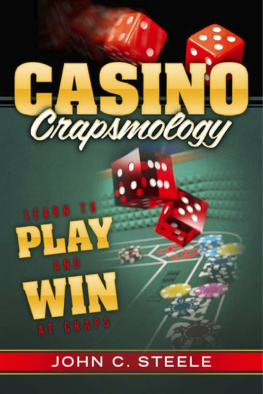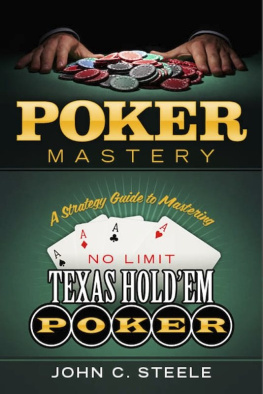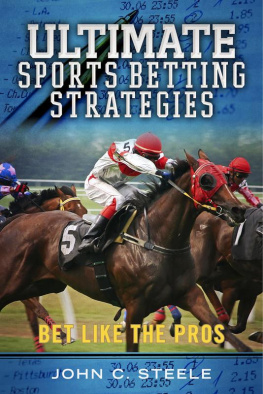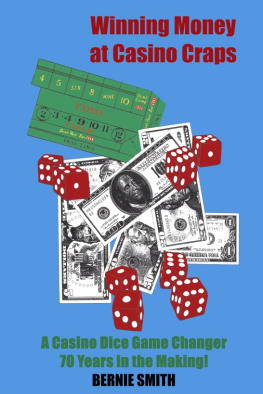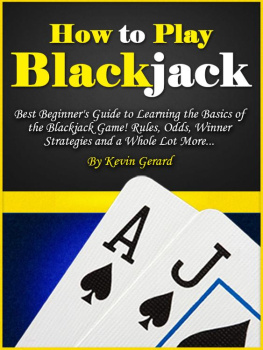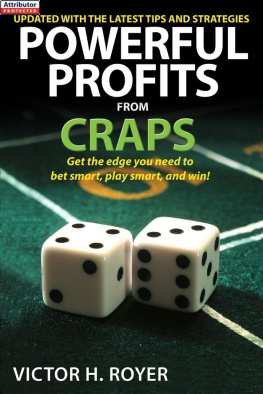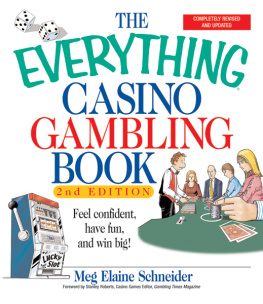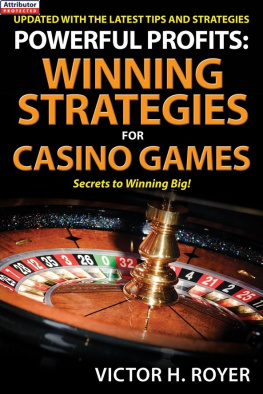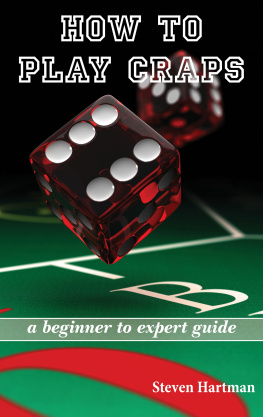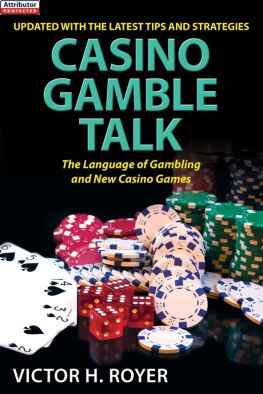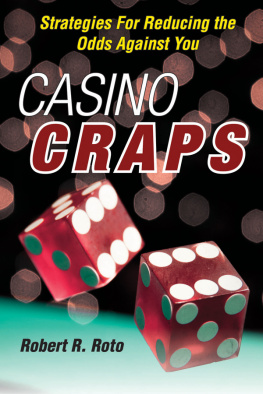Copyright (c) 2012
All rights reserved. No part of this book may be reproduced or transmitted in any form by any means graphic, electronic, or mechanical without permission in writing from the publisher or author.
This publication is designed to provide accurate and authoritative information in regard to the subject matter covered. The publisher or the author disclaims any personal loss or liability caused by utilization of any information presented herein.
Visit the authors website:
http://www.GamblingProTips.com
ISBN: 9781623094461
More Books by John C. Steele:
Roulette Secrets Revealed
Poker Mastery: A Strategy Guide to Mastering No Limit Texas HoldEm Poker
The Science of Blackjack: Card Counting Secrets and Strategies
Ultimate Sports Betting Strategies: Bet Like the Pros
How to Win BIG at Baccarat
Slot Machine Junkie: How to Win at Slots Consistently
Table of Contents
I. Introduction
Craps is one of the most exciting casino games around. The tables and everyone in the vicinity feels the electricity that surges from the fast moving game and the luck and fortunes that change hands with every throw of the die. Craps has a long history of being an equalizer, a game that is even parts luck and skill. The risk is always high even though the rules remain the same. No one comes to the table knowing more fact than anyone else. The winners just know how to approach slowly and observe the entire environment before literally laying their chips on the table. Although the basic throwing and betting can be studied, there are secrets that set the well read apart from the well prepared. In this book, we will outline everything you need to know to clean up at the Craps table or at the very least walk away even every time.
A. History
1. Origins
Craps is thought to come from an earlier game called Hazard. Hazard was actually created and came to popularity in Palestine during the Crusades in the 12th century A.D. The word Hazard actually comes from the Arabic word a1-zahr which means dice. The game carried dangerous consequences and brought the excitement of constant risk with it. Geoffrey Chaucer wrote of the ancient game of Hazard in The Canterbury Tales. He wrote about a timely gamblers oath which stated: Seven is my chance, and thine is cinque and trey. By Goddes armes, if thou falsely play, this dagger shall throughout thine hearte go. As the Crusaders brought the game back to their homelands, it became more and more popular in Europe.
The French introduced Hazard to the United States when they came to New Orleans. In the early 1700s French sailors were playing a game they called Crabs, which referred to the roll of two. Americans heard the French yelling Crabs! thought they heard Craps and so named their version of the raucous game. One of the selling points on all of these original players was the mobility of the game. It could be played anywhere from an alley to a galley, a packed bar or a game chamber. Anywhere there is a set of die and somebody who knows the right numbers to call, Craps can be played. And it takes its mercurial energy with it, around the world and through any and all class divisions or language differences.
2. Street Craps
Most everything we will address will be regarding casino or online Craps. But here we will acknowledge the longest lasting (and usually illegal version) of the game. Street Craps is the fastest and easiest way to win or lose money on the street. All you need is die and some cash and a game can get going anywhere. Street Craps became popular in the mid 1900s and is a simpler game, but with fewer rules come less predicable and trustworthy. Its a much riskier game both in terms of money and physical safety. The odds are the same. The betting is not. There is no banker or anything else and people only bet on Pass or No Pass. The Shooter places the first bet, then the next person to his left is asked whether he will cover the bet or part of it and then it goes to his left and so on clockwise around the circle. Most cover part of the shooters bet. After all of the shooters bet is covered, the players may bet against each other. People who bet with the shooter will wager against those who bet against him and vice versa.
Then the Come Out roll is thrown. If the Come Out is a 7 or 11, the Pass wagers win. If it is 2, 3 or 12, the No Pass wagers win. If it is any other combination or number, that number becomes the Point for the next throw. Betting is not done anew. All Pass bets turn into Come bets, meaning that the Point roll will be repeated before a 7. All Dont Pass bets become Dont Come bets, meaning that a 7 will be rolled before the Point roll is thrown again. The game is fast and loud and often starts with an agreement on a secondary or subsequent location should the police come and interrupt the current game so that no one fears for their bet money. And that is possible because, even more so than a casino, the game is fast and loud. Liberty (from arrest) is at stake as well as small fortunes of money. People get into the game and the crowd mentality and there is a great deal of pressure on the shooter at any time.
3. Refinement to current game
Once street Craps became clearly illegal, the game was moved onto riverboats in New Orleans. Thats when it was modified by dice maker extraordinaire John H. Winn started adding rules and rounds and made it so people could bet with or against the shooter. This was the first step toward Casino or Bank Craps as we know it today. The rounds and the rules for timing were developed. As the crowd was given permission to participate, it became even more popular and enigmatic of a game. Casinos were eager to get tables and introduce this fast-paced high yield game into its rooms and up the energy levels on the casino floor.
For this to be financially viable for the casinos, the house edge was built into the game. In Craps as in most games, the casino always wins to a certain extent or they would not exist. The house edge is an actual calculation of the casinos advantage over the shooter and other bettors in each game. Expressed as a percentage of the total betting or bank, it is important to track to figure out which games are beatable or at least more beatable than others.
The casino pays on what are called house odds. It takes some money out of the equation. Where in a straight bet between two people the odds would be 1 to 1, house odds are more like 0.95 to 1. The house pays the total even bet, minus its own share. So in the .95 to 1 example, the houses share is the 5% that is missing from the bank payout. Either the winning odds or the payout odds will be shifted in favor of the house so that every single game will pay them. Occasionally a seasoned player will be able to use the house edge to their own advantage, but for most it was built in to the equation to make sure even volatile and unpredictable games like Craps paid out the most important winnings first, to the host of the game.
When playing a game like Craps recreationally or competitively, an invested gambler will have the house edge in mind at all times because for every $500 bet, $25 dollars is automatically lost by most. As bets go up, that number can become quite significant, especially since it can go all the way up to 17% at some resorts and high roller tables. An alarming amount of people tend to disregard the house odds and it can be quite financially damning to do so.
Other than the house edge and formalized betting, Craps remains similar to the original game as it emerged from Hazard. Besides the pace and the potential yield of Casino Craps, it is still generally a small bet that has to be wagered to join a table, so all types of people usually confined to the slots can try their hand at this fast paced rock nroll game right on the casino floor. Craps has even contributed words to the language during its transition to acceptable, main stream culture. No dice, Crapshoot, and on a roll all became part of the English lexicon as the game became a casino staple.
Next page
